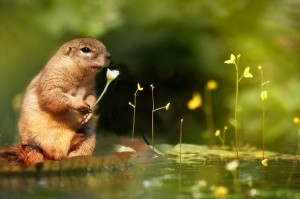Home
» Health and Safety, Natural Living, Organic » 8 Ways to Help the Environment Right in Your Own Backyard
8 Ways to Help the Environment Right in Your Own Backyard
| February 27, 2015 | Posted by eryn under Health and Safety, Natural Living, Organic |
 Since Spring planting season is almost upon us (it will get warmer eventually, right?), I wanted to do a quick post on some simple things you can do right in your own backyard to make it more eco-friendly.
Since Spring planting season is almost upon us (it will get warmer eventually, right?), I wanted to do a quick post on some simple things you can do right in your own backyard to make it more eco-friendly.
Here’s my list of the top 8 things you can do to increase the health of the ecosystem you live in:
- Reduce or eliminate your lawn. This is especially true if you live in an arid climate. It ain’t called Kentucky Blue Grass for nothin’, honey, and it don’t belong in Southern California. If you live someplace where you have to water your lawn, then that’s a clue that it’s not meant to be there. Opt instead for ornamental grasses, perennials, ground covers, moss in shady areas or desert foliage. The key is to search out species that are native to your area.
- Avoid synthetic pesticides. Rachel Carson warned about the detrimental effects of pesticides more than 50 years ago in Silent Spring and more studies come out every day linking pesticide use to problems from water contamination to health effects. Fortunately, there are many natural alternatives available, including everything from beneficial insects like ladybugs to homemade remedies like vinegar and water. And, remember, even organic pesticides should be used sparingly and with caution. This means you may also have to tolerate losing some of your plants to bugs.
- Limit or eliminate exotic plants. Non-native plants do not provide the same benefits to their environment as native species. Additionally, planting native species provides habitat for beneficial insects that act as natural pest controls and for other native wildlife species.
- Let Nature be your guide. This means not only choosing native plants, but also planting diverse species. Look to the natural world for ideas about what plants to select and how to plant them. One of my favorite ways to get ideas for plantings is to go to our state arboretum, which features a native plant area.
- Support your soil. Healthy soil makes for healthy plants and a healthy environment. Soil serves a number of ecological functions, including regulating water, sustaining plant and animal life, filtering and buffering pollutants, cycling nutrients and providing physical stability and support for plant roots, manmade structures and archaeological treasures. One way you can help to improve soil health is by adding organic matter such as compost, manures, mulches or peat moss.
- Embrace nature’s messiness. A healthy environment is not necessarily an orderly one. Some “messy” things—including dead logs, brush piles and tree snags—are better left alone because they also provide important habitat for many critters. Also, if you leave your perennials standing through the winter rather than taking them out, they will provide food and cover for birds and insects.
- Choose single-flowered plants. Single-flowered plants often have more nectar, pollen and seed than double-flowered varieties, so it makes sense to opt for them when you can.
- Consider providing a water source. Water is a critical resource for many species of wildlife and insects. But do take into consideration that standing water can be a breeding ground for mosquitoes, which can carry diseases like West Nile Virus.
What are your tips for an eco-friendly backyard?




